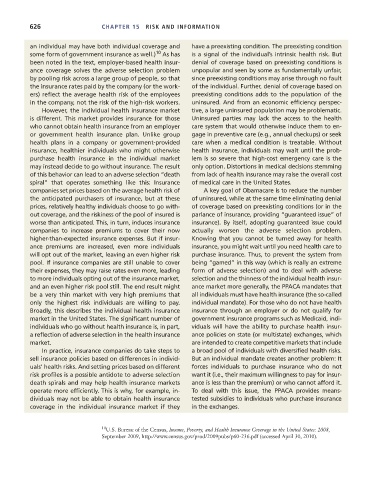Page 652 - Microeconomics, Fourth Edition
P. 652
c15riskandinformation.qxd 8/16/10 11:10 AM Page 626
626 CHAPTER 15 RISK AND INFORMATION
an individual may have both individual coverage and have a preexisting condition. The preexisting condition
some form of government insurance as well.) 10 As has is a signal of the individual’s intrinsic health risk. But
been noted in the text, employer-based health insur- denial of coverage based on preexisting conditions is
ance coverage solves the adverse selection problem unpopular and seen by some as fundamentally unfair,
by pooling risk across a large group of people, so that since preexisting conditions may arise through no fault
the insurance rates paid by the company (or the work- of the individual. Further, denial of coverage based on
ers) reflect the average health risk of the employees preexisting conditions adds to the population of the
in the company, not the risk of the high-risk workers. uninsured. And from an economic efficiency perspec-
However, the individual health insurance market tive, a large uninsured population may be problematic.
is different. This market provides insurance for those Uninsured parties may lack the access to the health
who cannot obtain health insurance from an employer care system that would otherwise induce them to en-
or government health insurance plan. Unlike group gage in preventive care (e.g., annual checkups) or seek
health plans in a company or government-provided care when a medical condition is treatable. Without
insurance, healthier individuals who might otherwise health insurance, individuals may wait until the prob-
purchase health insurance in the individual market lem is so severe that high-cost emergency care is the
may instead decide to go without insurance. The result only option. Distortions in medical decisions stemming
of this behavior can lead to an adverse selection “death from lack of health insurance may raise the overall cost
spiral” that operates something like this: Insurance of medical care in the United States.
companies set prices based on the average health risk of A key goal of Obamacare is to reduce the number
the anticipated purchasers of insurance, but at these of uninsured, while at the same time eliminating denial
prices, relatively healthy individuals choose to go with- of coverage based on preexisting conditions (or in the
out coverage, and the riskiness of the pool of insured is parlance of insurance, providing “guaranteed issue” of
worse than anticipated. This, in turn, induces insurance insurance). By itself, adopting guaranteed issue could
companies to increase premiums to cover their now actually worsen the adverse selection problem.
higher-than-expected insurance expenses. But if insur- Knowing that you cannot be turned away for health
ance premiums are increased, even more individuals insurance, you might wait until you need health care to
will opt out of the market, leaving an even higher risk purchase insurance. Thus, to prevent the system from
pool. If insurance companies are still unable to cover being “gamed” in this way (which is really an extreme
their expenses, they may raise rates even more, leading form of adverse selection) and to deal with adverse
to more individuals opting out of the insurance market, selection and the thinness of the individual health insur-
and an even higher risk pool still. The end result might ance market more generally, the PPACA mandates that
be a very thin market with very high premiums that all individuals must have health insurance (the so-called
only the highest risk individuals are willing to pay. individual mandate). For those who do not have health
Broadly, this describes the individual health insurance insurance through an employer or do not qualify for
market in the United States. The significant number of government insurance programs such as Medicaid, indi-
individuals who go without health insurance is, in part, viduals will have the ability to purchase health insur-
a reflection of adverse selection in the health insurance ance policies on state (or multistate) exchanges, which
market. are intended to create competitive markets that include
In practice, insurance companies do take steps to a broad pool of individuals with diversified health risks.
sell insurance policies based on differences in individ- But an individual mandate creates another problem: It
uals’ health risks. And setting prices based on different forces individuals to purchase insurance who do not
risk profiles is a possible antidote to adverse selection want it (i.e., their maximum willingness to pay for insur-
death spirals and may help health insurance markets ance is less than the premium) or who cannot afford it.
operate more efficiently. This is why, for example, in- To deal with this issue, the PPACA provides means-
dividuals may not be able to obtain health insurance tested subsidies to individuals who purchase insurance
coverage in the individual insurance market if they in the exchanges.
10 U.S. Bureau of the Census, Income, Poverty, and Health Insurance Coverage in the United States: 2008,
September 2009, http://www.census.gov/prod/2009pubs/p60-236.pdf (accessed April 30, 2010).

